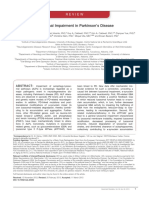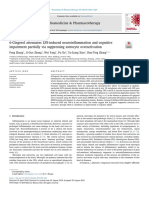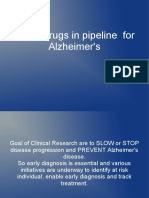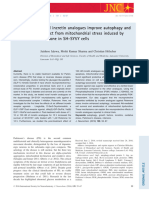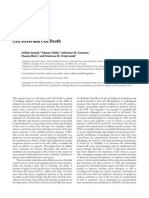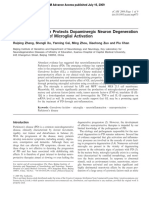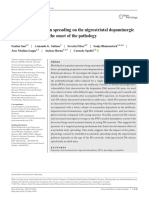Is A Treatment For Alzheimers and Parkinsons Within Grasp
Is A Treatment For Alzheimers and Parkinsons Within Grasp
Uploaded by
Debbie GraingerCopyright:
Available Formats
Is A Treatment For Alzheimers and Parkinsons Within Grasp
Is A Treatment For Alzheimers and Parkinsons Within Grasp
Uploaded by
Debbie GraingerOriginal Title
Copyright
Available Formats
Share this document
Did you find this document useful?
Is this content inappropriate?
Copyright:
Available Formats
Is A Treatment For Alzheimers and Parkinsons Within Grasp
Is A Treatment For Alzheimers and Parkinsons Within Grasp
Uploaded by
Debbie GraingerCopyright:
Available Formats
blo g.pt glab.
co m
http://blo g.ptglab.co m/index.php/is-a-treatment-fo r-alzheimers-and-parkinso ns-within-grasp/
Is a Treatment for Alzheimers and Parkinsons Within Grasp?
by Deborah Grainger Last week our attention was turned to an article on the BBC News website, which hails one of the biggest discoveries in neurodegenerative disease research of 2013: scientists based at the University of Leicester, UK, may have f ound a way of stopping neurodegeneration in its tracks. It could mean that an ef f ective treatment f or diseases such as Alzheimers and Parkinsons are within reach. T he article ref ers to a paper published by Giovanna Malluccis lab in the journal Science Translational Medicine. It reports successful blockade of prion-disease progression by targeting the unfolded protein response (UPR) with an experimental compound. When given orally to prion-inf ected mice, the compound, a specif ic inhibitor of a key UPR kinase, prevented the emergence of clinical disease and the progression of neurodegeneration. T his builds on the labs previous work, published here in Nature, which showed that a build-up of misf olded proteins over-activates the UPR and shif ts cells towards protein production shutdown and an apoptotic f ate. Furthermore, the same Nature paper provided the initial evidence that targeting the UPR pathway, shif ting cells back towards protein production and not self -destruction, might be a usef ul strategy in preserving the integrity of neurons, despite the protein aggregation occurring within them. Protein aggregation and UPR over-activity are not just limited to prion diseases; they are a common f eature of other neurodegenerative conditions. T heref ore, the most exciting prospect of f ered by the work of the Mallucci lab is that of a universal treatment f or neurodegenerative disease, potentially applicable (but not limited to) Alzheimers, Parkinsons and Huntingtons. T he disease-causing culprits may be dif f erent in each case amyloid-beta accumulation in Alzheimers and alpha-synuclein in Parkinsons but their buildup results in the same def ense mechanisms being activated via the UPR. A treatment (or treatments) targeting this pathway would be a boon f or managing a vast array of dementias and wasting diseases; plus, paired with enhanced detection methods such treatment options could greatly reduce the burden these diseases put on healthcare systems worldwide. Bef ore that stage is reached, however, a lot more work is needed. T heres a long way to go f rom mouse to human, and one of the most important steps required is the development of a saf e, alternative drug; the compound of the current study comes with unwanted side ef f ects including weight loss and mild diabetes due to pancreatic damage. Prof essor Mallucci has appealed to the wider scientif ic community and pharmaceutical companies alike to help the design of therapeutic compounds that will saf ely target the UPR kinase identif ied in her labs latest study. Read related article Alzheimers breakthrough: Cure or hype? on the BBC News website.
More about t he UPR
Correct f olding of secreted and transmembrane proteins is f acilitated by several chaperone proteins in the endoplasmic reticulum (ER). Under physiological conditions the UPR operates as a protective mechanism, maintaining f olding homeostasis in the ER. It is induced in response to cellular and ERstress by dissociation of the molecular Re ad Alz he ime rs b re akthro ug h: Cure o r hyp e o n the BBC Ne ws we b s ite . (Imag e s o urc e : BBC Ne ws , SPL) chaperone GRP78/BiP f rom three proteins that initiate the UPR response: PERK, IRE1 and AFT 6. Stressors can take the f orm of amino acid deprivation, viral replication and, as the name suggests, the presence of unf olded proteins. T he UPR elicits its protective ef f ects through several actions, including: 1) Increasing chaperone protein expression to prevent protein aggregation and f acilitate correct protein f olding. T his can be induced by AFT 6 expression of XBP1 and subsequent splicing of XBP1 mRNA by IRE1a. 2) Reducing protein translation to lower the amount of proteins present in the ER. T his is initiated by phosphorylation of eukaryotic initiation f actor 2a (eIF2a) by PERK. GADD34 dephosphorylates eIF2a once the ER stress has been resolved and any unf olded proteins have been removed. Increases in PERK and eIF2 phosphorylation have been recorded in the brains of Alzheimers, Parkinsons, ALS (Lou Gherigs), and prion disease patients. 3) Stimulating lipid synthesis to increase ER volume.
4) And degrading unf olded proteins by activation of the ER-associated protein degradation (ERAD) pathway. Under conditions of prolonged stress, the goal of the UPR changes f rom one that promotes cellular survival to one that commits to apoptosis. On a small scale this last resort is protective, but such conditions develop on a larger scale in neurodegenerative disease, causing widespread damage. In its 2012 Nature paper the Mallucci lab showed that accumulation of misf olded prion protein in the brains of priondiseased mice caused such sustained overactivation of the PERK/eIF2 branch of the UPR that a critical decline in levels of key proteins, including synaptic proteins, occurs. Essentially, persistently high levels of phosphorylated eIF2 (eIF2-P) lead to neurodegeneration through sustained, uncompensated repression of protein synthesis. T he latest Mallucci lab study shows that by reversing the haitus on protein production by targeting the PERK-eIF2 branch of the UPR pharmacologically, the protective mechanisms of the UPR can be reinstated and protect neurons in conditions that would otherwise result in neurodegeneration.
You might also like
- Time in Psychoanalysis: Some Contradictory AspectsDocument185 pagesTime in Psychoanalysis: Some Contradictory AspectsDrustvo Mrtvih Slikara100% (1)
- KetogenikDocument7 pagesKetogeniksari rezekiNo ratings yet
- Spektro Uv VisDocument7 pagesSpektro Uv VisNadaNo ratings yet
- (Digital) Aneuro-eBook-PFFsDocument8 pages(Digital) Aneuro-eBook-PFFsgeorgescumirelaligiaNo ratings yet
- Lysosomal Impairment in Parkinson's Disease: ReviewDocument8 pagesLysosomal Impairment in Parkinson's Disease: ReviewRara Aulia IINo ratings yet
- Zhang 2018Document7 pagesZhang 2018Jonas Ricardo Pereira Júnior RicardoNo ratings yet
- Curcumin ADocument14 pagesCurcumin AflororaffaeleNo ratings yet
- 神经炎症SE1Document16 pages神经炎症SE1736984394cjcNo ratings yet
- Newer Drugs in Pipeline For Alzheimer'sDocument40 pagesNewer Drugs in Pipeline For Alzheimer'sArun KrishnanNo ratings yet
- TNF FreshDocument5 pagesTNF Freshrifahnanjiba2001No ratings yet
- Autologous Mesenchymal Stem Cell Therapy For Progressive Supranuclear Palsy: Translation Into A Phase I Controlled, Randomized Clinical StudyDocument13 pagesAutologous Mesenchymal Stem Cell Therapy For Progressive Supranuclear Palsy: Translation Into A Phase I Controlled, Randomized Clinical Studyt108No ratings yet
- Western Blot - Paper 11Document4 pagesWestern Blot - Paper 11Umme BegumNo ratings yet
- MMJ Publication 2011Document4 pagesMMJ Publication 2011BijuKuriliKattleNo ratings yet
- Accumulation of Abnormally Processed Tau Protein in Neuronal Cells As A Biomarker For DementiaDocument20 pagesAccumulation of Abnormally Processed Tau Protein in Neuronal Cells As A Biomarker For Dementiakj185No ratings yet
- Independent and combined effects of astaxanthin and omega-3 on behavioral deficits and molecuDocument18 pagesIndependent and combined effects of astaxanthin and omega-3 on behavioral deficits and molecuRITA DE CÁSSIA ALVES NUNESNo ratings yet
- Journal of Neurochemistry - 2016 - Jalewa - Novel Incretin Analogues Improve Autophagy and Protect From MitochondrialDocument13 pagesJournal of Neurochemistry - 2016 - Jalewa - Novel Incretin Analogues Improve Autophagy and Protect From Mitochondrialjalewa.jaishreeNo ratings yet
- awac273Document17 pagesawac273juanberon1991No ratings yet
- Drosophila Melanogaster 2Document7 pagesDrosophila Melanogaster 2ahuoizazayNo ratings yet
- UprgenyDocument9 pagesUprgenyJose Rafael Villafan BernalNo ratings yet
- Epilepsia - 2020 - Contel - High ConcordanceDocument16 pagesEpilepsia - 2020 - Contel - High Concordanceloherjulian6No ratings yet
- Apd 2014052911520861Document4 pagesApd 2014052911520861Azzahra JihanNo ratings yet
- Cells 11 00678Document15 pagesCells 11 00678Juan Pablo Erazo AlvaradoNo ratings yet
- Animal Model of EADocument13 pagesAnimal Model of EAzigurat00No ratings yet
- Hou-2017-NADPH Oxidase-Derived H2O2 Mediates TDocument9 pagesHou-2017-NADPH Oxidase-Derived H2O2 Mediates Tthai haNo ratings yet
- PRD 89 59Document24 pagesPRD 89 59vrht2xyvsdNo ratings yet
- Melatonin Use For Neuroprotection in Perinatal Asphyxia: A Randomized Controlled Pilot StudyDocument6 pagesMelatonin Use For Neuroprotection in Perinatal Asphyxia: A Randomized Controlled Pilot StudyJavier Miranda MalleaNo ratings yet
- The Herbal Cure For Epilepsy: An: Review ArticleDocument6 pagesThe Herbal Cure For Epilepsy: An: Review ArticleNerissa AlvianaNo ratings yet
- Metabolic and Neurobehavioral Disturbances Induced by Purine Recycling Deficiency in DrosophilaDocument34 pagesMetabolic and Neurobehavioral Disturbances Induced by Purine Recycling Deficiency in Drosophilafabien.delcourtNo ratings yet
- Cell StressDocument2 pagesCell StressandrileaNo ratings yet
- NAP ZNDocument9 pagesNAP ZNancuta.lupaescuNo ratings yet
- Autophagy PapersDocument7 pagesAutophagy PapersKudumarNo ratings yet
- 1a. 24609742 Neurobiology of PainDocument6 pages1a. 24609742 Neurobiology of PainJason HillNo ratings yet
- Acetaminophen-Induced Liver Injury: From Animal Models To HumansDocument8 pagesAcetaminophen-Induced Liver Injury: From Animal Models To HumansMiguel Adrian GaonaNo ratings yet
- Ganoderma Lucidum Protects Dopaminergic Neuron Degeneration Through Inhibition of Microglial ActivationDocument9 pagesGanoderma Lucidum Protects Dopaminergic Neuron Degeneration Through Inhibition of Microglial ActivationDr. Kaushal Kishor SharmaNo ratings yet
- 2018-Piperlongumine Restores The Balance of Autophagy and Apoptosis by Increasing BCL2 Phosphorylation in Rotenone Induced Parkinson Disease ModelsDocument18 pages2018-Piperlongumine Restores The Balance of Autophagy and Apoptosis by Increasing BCL2 Phosphorylation in Rotenone Induced Parkinson Disease Models赵冠丁No ratings yet
- The Metabotropic Purinergic P2Y Receptor Family As Novel Drug Target in EpilepsyDocument12 pagesThe Metabotropic Purinergic P2Y Receptor Family As Novel Drug Target in EpilepsymhcolinaNo ratings yet
- Paper P53Document18 pagesPaper P53LidiaAlejandraRiveraPonceNo ratings yet
- Late-Onset Alzheimers Disease Is Associated WithDocument13 pagesLate-Onset Alzheimers Disease Is Associated WithAlix AliNo ratings yet
- (BestMedDiss) Elisabeth Salzer (Auth.) - Identifying Novel IDocument91 pages(BestMedDiss) Elisabeth Salzer (Auth.) - Identifying Novel Igratiela2210100% (1)
- Karen 2013 Effect of Propofol in The Immature Rat Brain On Short - and Long-Term Neurodevelopmental OutcomeDocument11 pagesKaren 2013 Effect of Propofol in The Immature Rat Brain On Short - and Long-Term Neurodevelopmental OutcomePablo MartinezNo ratings yet
- Sudhir KumarDocument7 pagesSudhir Kumargaurav saxenaNo ratings yet
- Quercetin Alleviates Kainic Acid-Induced Seizure by Inhibiting The Nrf2-Mediated Ferroptosis PathwayDocument15 pagesQuercetin Alleviates Kainic Acid-Induced Seizure by Inhibiting The Nrf2-Mediated Ferroptosis PathwayOnder ErtemNo ratings yet
- A Radiation Induced Accelerated SenescenceDocument3 pagesA Radiation Induced Accelerated SenescenceAndrea MorenoNo ratings yet
- 799Document8 pages799fadimeatesNo ratings yet
- Richa Et Al., 2010 - MacroprolactinDocument7 pagesRicha Et Al., 2010 - MacroprolactinTinaNo ratings yet
- Treatment of Pilocarpine-Induced Epileptic Seizures in Adult Male MiceDocument6 pagesTreatment of Pilocarpine-Induced Epileptic Seizures in Adult Male MiceLuliNo ratings yet
- Animal Models Short Exam EssayDocument8 pagesAnimal Models Short Exam EssayscholifyNo ratings yet
- Fibrinogen Inhibits Metalloproteinase 9 ActivationDocument7 pagesFibrinogen Inhibits Metalloproteinase 9 ActivationEmii RivadeneiraNo ratings yet
- Nature Targeting Tp53 Cell CycleDocument20 pagesNature Targeting Tp53 Cell CycleKamariah IbrahimNo ratings yet
- Giardia duodenalis-ER InvitroDocument12 pagesGiardia duodenalis-ER InvitroSupratim GhoshNo ratings yet
- ApoE2 GT For AD 2023Document43 pagesApoE2 GT For AD 2023Ram KNo ratings yet
- Preprints202410.1251.v1 2Document13 pagesPreprints202410.1251.v1 2Felipe BecerraNo ratings yet
- Davidson 2013Document15 pagesDavidson 2013Jorge CastroNo ratings yet
- Inborn Errors of Purine and Pyrimidine Metabolism: Journal of Inherited Metabolic Disease April 2009Document18 pagesInborn Errors of Purine and Pyrimidine Metabolism: Journal of Inherited Metabolic Disease April 2009Timi BelaidiNo ratings yet
- 2020 Emerging Role of ER Stress in Balancing ImmunityDocument15 pages2020 Emerging Role of ER Stress in Balancing ImmunityRaul ReyesNo ratings yet
- Antioxidants 12 00280Document62 pagesAntioxidants 12 00280emeo145No ratings yet
- Interleukin-1, Interleukin-6, and Antagonist Interleukin-1Receptor As Memory Impairment Risk Factor in Complex Partial EpilepsyDocument4 pagesInterleukin-1, Interleukin-6, and Antagonist Interleukin-1Receptor As Memory Impairment Risk Factor in Complex Partial Epilepsycindy rahayu putriNo ratings yet
- BPA 32 E13036Document18 pagesBPA 32 E13036Valentina MartinezNo ratings yet
- Cuadrado NFE2L2 - NRF2Document15 pagesCuadrado NFE2L2 - NRF2Helena QuintNo ratings yet
- Neurometabolic Hereditary Diseases of AdultsFrom EverandNeurometabolic Hereditary Diseases of AdultsAlessandro P. BurlinaNo ratings yet
- Neuroimmunology: Multiple Sclerosis, Autoimmune Neurology and Related DiseasesFrom EverandNeuroimmunology: Multiple Sclerosis, Autoimmune Neurology and Related DiseasesAmanda L. PiquetNo ratings yet
- Physical Examination / Health Assessment Abnormal Findings Patient Findings General Survey Blood PressureDocument17 pagesPhysical Examination / Health Assessment Abnormal Findings Patient Findings General Survey Blood PressureyllearieNo ratings yet
- Al Capone Does My GrammarDocument4 pagesAl Capone Does My GrammarHanky PurnamaNo ratings yet
- Memorandum of SocietiesDocument8 pagesMemorandum of SocietiesAgniva SinhaaNo ratings yet
- Pharmaceutical JurisprudenceDocument2 pagesPharmaceutical JurisprudenceMasum Billa MollaNo ratings yet
- BFP Group 6Document11 pagesBFP Group 6Marichelle Antivo MediloNo ratings yet
- External Validation of SAFE Score To Predict Atrial Fibrillation Diagnosis After Ischemic Stroke: A Retrospective Multicenter StudyDocument8 pagesExternal Validation of SAFE Score To Predict Atrial Fibrillation Diagnosis After Ischemic Stroke: A Retrospective Multicenter Studyfrco.javier.sanchezNo ratings yet
- Linda S. Smith, PH.D., AFCC CT PresidentDocument15 pagesLinda S. Smith, PH.D., AFCC CT PresidentJournalistABC100% (2)
- EDU209 Cheat Sheet 1Document6 pagesEDU209 Cheat Sheet 1teaheeNo ratings yet
- Year 10 HealthDocument1 pageYear 10 Healthapi-296371147No ratings yet
- Answer - Fundamentals of Nursing IV: Nursing Process, Physical and Health Assessment and Routine ProceduresDocument15 pagesAnswer - Fundamentals of Nursing IV: Nursing Process, Physical and Health Assessment and Routine ProceduresMae UsquisaNo ratings yet
- NHCP Guidelines PDFDocument15 pagesNHCP Guidelines PDFSuraj MandalNo ratings yet
- Benefits of Jatropha CurcasDocument4 pagesBenefits of Jatropha Curcascliffe cvNo ratings yet
- Toberevised ThesisDocument34 pagesToberevised ThesisCharrie Faye Magbitang HernandezNo ratings yet
- Nicu Neonatal Pneumonia ArticleDocument13 pagesNicu Neonatal Pneumonia ArticleJomer HeyresNo ratings yet
- Herpes ZosterDocument12 pagesHerpes ZosterCharlz ZipaganNo ratings yet
- DCF Report January 1, 2018Document2 pagesDCF Report January 1, 2018Julia JenaeNo ratings yet
- AL11081 AFP M2JobAidAddendumDocument2 pagesAL11081 AFP M2JobAidAddendumtaibkNo ratings yet
- Hydranencephaly: A Rare Cause of An Enlarging Head Size in An InfantDocument3 pagesHydranencephaly: A Rare Cause of An Enlarging Head Size in An InfantdyahNo ratings yet
- How School Systems Can Improve Health and Well-BeingDocument8 pagesHow School Systems Can Improve Health and Well-BeingMedia MCRNo ratings yet
- Konsep Organisasi Dan Manajemen Dan PerencanaanDocument95 pagesKonsep Organisasi Dan Manajemen Dan PerencanaanGiselleNo ratings yet
- Zno Leader b2 Keys - 1634804539 PDFDocument1 pageZno Leader b2 Keys - 1634804539 PDFДиана Шерепа0% (1)
- Missouri Medical Record Release Form 1Document1 pageMissouri Medical Record Release Form 1itargetingNo ratings yet
- Process Industry Practices Insulation: PIP INTG1000 Insulation Inspection ChecklistDocument7 pagesProcess Industry Practices Insulation: PIP INTG1000 Insulation Inspection ChecklistCristian Jhair PerezNo ratings yet
- Ayham Ghraowi enDocument8 pagesAyham Ghraowi enAngelon SagardiaNo ratings yet
- Tear FilmDocument21 pagesTear FilmAshish PawarNo ratings yet
- DBQuest ProfileDocument2 pagesDBQuest ProfileAli CapatiNo ratings yet
- Apprentice Act, 1961: Unit 1Document5 pagesApprentice Act, 1961: Unit 1singhashish5444No ratings yet
- Lesson 3 - Basic Principles of Physical FitnessDocument20 pagesLesson 3 - Basic Principles of Physical FitnessJohn Michael AgustinNo ratings yet
- Cap 3Document24 pagesCap 3Elena DimitriuNo ratings yet




